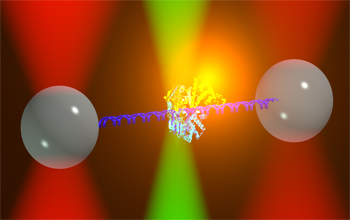Multimedia Gallery
Combined Molecular Study Techniques
Researchers at the University of Illinois (UI) at Urbana-Champaign have combined two molecular imaging technologies to create an instrument with incredible sensitivity that provides new detailed insight into dynamic molecular processes. The new technique combines optical traps with fluorescence. In this illustration, ultra-high-resolution optical traps are combined with single molecule fluorescence detection. The image shows DNA (blue double helix) streched out between two beads (gray spheres) held by optical traps (red cones) with a bound protein glowing with fluorescence excited by a confocal laser (green cones).
This research was directly funded through the National Science Foundation Center for the Physics of Living Cells. To learn more about this research, see the UI news story Combined molecular study techniques reveal more about DNA proteins. Further information about the center is available Here. (Date of Image: February 2011)
Credit: Matthew Comstock, Center for the Physics of Living Cells, University of Illinois
See other images like this on your iPhone or iPad download NSF Science Zone on the Apple App Store.
Images and other media in the National Science Foundation Multimedia Gallery are available for use in print and electronic material by NSF employees, members of the media, university staff, teachers and the general public. All media in the gallery are intended for personal, educational and nonprofit/non-commercial use only.
Images credited to the National Science Foundation, a federal agency, are in the public domain. The images were created by employees of the United States Government as part of their official duties or prepared by contractors as "works for hire" for NSF. You may freely use NSF-credited images and, at your discretion, credit NSF with a "Courtesy: National Science Foundation" notation.
Additional information about general usage can be found in Conditions.
Also Available:
Download the high-resolution JPG version of the image. (245 KB)
Use your mouse to right-click (Mac users may need to Ctrl-click) the link above and choose the option that will save the file or target to your computer.

